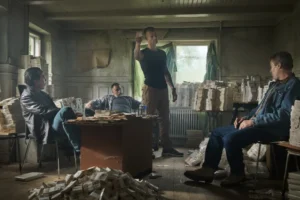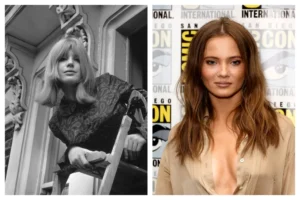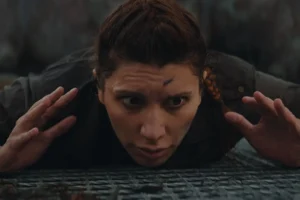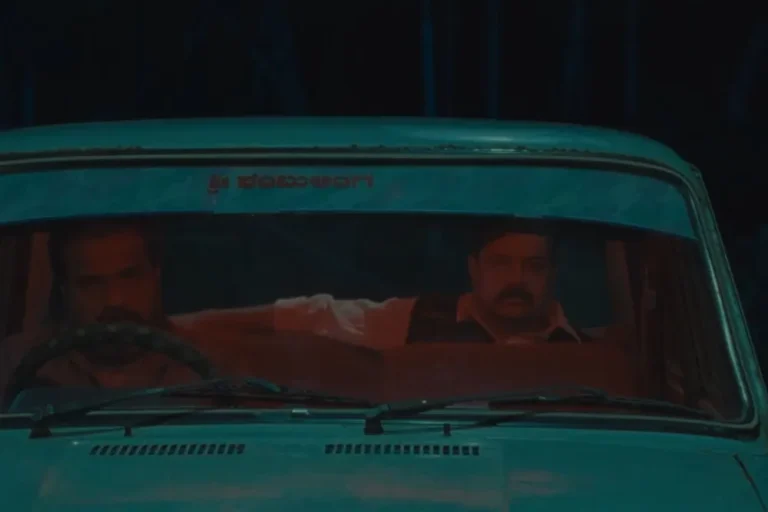by Sean Cubitt
Bitmap, Colour, Codec
The meaning of the term cinema has changed. Today we experience film across large and small screens, only relatively rarely projected outside lecture halls and the theatrical circuits. We watch in aircraft, on the bus, on handhelds, with earphones, on TV and plasma screens, tape, DVD and Blu-Ray and a dozen internet formats. The 35mm photographic film that gave the medium its name is no longer universal in filming, passing out of post-production, and scheduled for demolition in distribution. As a community of scholars we are still trying to understand what it is that we are looking at now.
The experience of digital cinema starts with screens. The two major formats for digital projection – digital light projection (DLP) and Liquid Crystal on Silicon (LCOS) are geometrically the same as the dominant formats for fixed fluorescent screens, liquid crystal displays (LCD) and plasma screens. Big architectural screens using light-emitting diodes (LEDs) share the same structure. It even dominates the formats of digital cameras, charge-coupled devices (CCD) and complementary metal–oxide semiconductor (CMOS) chips. This geometry is the rectangular grid of pixels ordered arithmetically from top left. Because it is designed to handle any output from a computer, such screen displays are more deeply sealed into contemporary screen culture than, say, standard aspect ratios were in the cinema. However your image is produced, it has to be displayed on the raster grid, also known as the bitmap display.
There is an interesting history to this, stretching back to half-tone printing and the development of wire photos, the former essential to mass dissemination, the latter to journalistic speed in transmission, of photography. The principle of synchronised scanning moved from experiments with pioneer fax technologies around 1900 into the cathode ray tube (CRT). The old CRTs were pretty blurry, so Sony introduced the Trinitron which placed a ‘shadow mask’, a grid of fine lines between the more or less random spray of phosphorescent molecules lining the inside of the tube, to give the impression both of richer blacks, and of crisper definition. The shadow mask principle was adopted for computer displays, where each spot on the screen was given a numerical address – so many pixels to the right or below the origin at top left. Those addresses now are hardwired into the computer’s operating system. Redesigning the screen would mean redesigning pretty much everything from the operating system up.
The other numerical factor in digital displays is the colour depth, defined by the number of bits allocated per pixel. Obviously the more data you attach to each pixel, the larger the number of colours that can be shown. The problem is the second factor in colour display, the gamut, which is the range of colours that can be shown. In pretty much any of the devices I just listed, cameras included, and in the vast majority of printers, the gamut is only around 40% of the visible spectrum. Some colours are just hard to get with the standard colours of phosphors – red, green and blue. The RGB gamut isn’t very good at bright yellow, which in the human retina overlaps the red (actually in our eyes more orange) and green cones, and so appears the brightest of colours (Sharp introduced a new four colour TV system ACQUOS Quattron, including yellow pixels in 2010. Unavailable as yet in Australia, the author has been unable to assess their optical qualities: http://ces.cnet.com/8301-31045_1-10426897-269.html). RGB phosphors don’t quite match the breadth of wavebands of the respective cones in the human eye, and across much of the spectrum they can’t achieve the same brightness. This happens especially with blues: we are highly sensitive to blue, which overlaps with our scotopic (colourless) night vision: we can see way into the blue end of the spectrum. But getting that dim region to shine brightly on screens would take too much power (and generate too much heat). So software engineers bring in a third tool in colour management: colour difference. Various input devices, like cameras, record the fact that light of the visible wavelengths is arriving. They pass that data on to the software. The software then squeezes the incoming light into the available gamut. But rather than simply move the extreme blues and yellows etcetera into the nearest available spot, they calculate the difference between colours – say between a mauve and a magenta – and try to keep the relative difference between them. The whole convolution moves all the colours, not just the extreme ones, so the result looks as if it has as much colour contrast, even though there is a lesser total range than in ordinary visible light.
So the screen is a grid, and the colour is manipulated. The third major factor in digital display is the compression-decompression algorithms or codecs. To get from visible light to a computer screen, the wavelengths of light are converted into numbers matching the colours, and addresses matching where they are to appear. That is a considerable number of numbers for each pixel. For a good domestic 1280×1024 high definition display, that would be 1,310,720 pixels – and the address of the bottom right quadrant pixels have to have a minimum of eight digits in their addresses (obviously more in binary!). Change these values once every 25th of a second over the two-hour runtime of a feature film and you see the problem: vast quantities of data (and we haven’t mentioned sound yet).
A similar problem arises even in shooting with digital cameras. An individual ‘frame’ is exposed: the light causes the release of electrons. That creates charge. The charge is guided through the use of positively and negatively charged gutters in the chip through a timer gate into storage. So far it is just charge – the equivalent of the latent image in traditional photography. It has to be converted into numbers in order to be taken over into digital storage. Typically this is handled by processing the collected data in batches called blocks or groups of blocks: four neighbouring pixels, or sixteen, checked to see whether they are pretty much the same colour. If so, the same colour number is applied to the lot, making it much quicker to get them out of the vulnerable charge state and into the digital state, so making room for the next frame one 25th of a second later.
Getting data from the camera’s storage into a computer, and then into editing software may require other compression phases. Previewing on a monitor requires further compression. Then there’s the question of delivering it to audiences. Terrestrial broadcasting used pretty strenuous compression to get the data through crowded airwaves. Internet and mobile media likewise: even with broadband, time and the cost per byte of data transfer have to be balanced against the resolution, colour depth and accuracy that viewers will accept. Even DVD has to fit everything onto a finite space, and get it from the disc to the screen as rapidly as possibly, This is the work of codecs. To cut a long story short, all codecs crush the image. YouTube crushes hard. A Blu-Ray movie or an FC Pro file crush considerably less. But everything from the moment of digitisation on is crushed. I need only make one last point: the means for doing this includes a process called vector prediction.
This is infuriating, only partly because vectors have a very different role elsewhere in digital imaging. Animators will recognise the principles: the codec seeks out keyframes where there is substantial change across the whole field of the image. Then it automates in-betweening to get from the first keyframe in a sequence to the last, sampling as it goes along to update and check for basic accuracy. The idea is that if you’re watching the cricket, you aren’t watching the grass, which can be relied on to stay the same colour. Big saving in information. Vector prediction then tells the software which areas of the image seem to change most and which least from frame to frame. Those that don’t change come out as blocky patches because the unit is those Groups of Blocks, fetchingly referred to as GoBs.
So what does all this mean? I’ll concentrate on one device where three features come together, the CCD chip standard in most digital video and still cameras. Light comes in as a rain of photons over the duration that the shutter is open: let’s say slightly less than a 25th of a second for a video frame. The photons have different wavelengths, and even though they arrive over a very short period by human standards, recall that they are travelling at the speed of light. There are lots of them. When they arrive, they react with the CCD to produce a charge. This charge is an average of the wavelengths of all the different photons, and the average is applied across the width of the pixel square. This averaging involves effectively sampling from the whole spectrum falling in the square and arriving at a single figure to represent it. When the charge is deposited in digital form for storage, the average is rounded up or down to a whole number – there are no digital fractions. The frequency of the averaged wave form, what we see is a colour, is then managed, convoluted to match the available colour gamut. The question here is not proximity to human vision but the translation of flux into averaged unit steps. The process is geared towards a good-enough rendering of the scene, as measured against the visual perception of a standard observer.
The standard observer also has an interesting history. In 1931, arguments between physicists and psychologists over how to standardise colour descriptions reached a pitch. Both agreed that the Commission International de l’Eclairage, one of the older international standards bodies, had as a remit the task of providing metrics for the notoriously unstable and tricky field of pigments, dyes and light-sources. How could you guarantee that the colour of your flag was the same from year to year, given the vagaries of bleaching, fading, rapidly changing industrial colour manufacture, different printing technologies and their inks, different conditions of illumination? Unable to find a common language, the dispute over whether colour was a matter of the physics of frequency or the subjective impression of observers under different light conditions, talks were deadlocked until a group of US psychologists, inspired by the ‘social physics of Alphonse Quetelet, inventor of statistical techniques for sociology, (1) tested a group of students. Testing their responses to colour cards under different lighting conditions, they constructed, – as Quetelet had constructed the ‘average man’ – a standard observer. (2) It is, I believe, a triumphant moment in the establishment of what Michel Foucault calls biopolitics (3): the replacement of rule through panoptic discipline by the management of populations through probability and statistical goal-setting.
At the same time, the whole-number enumeration of things parallels another critical factor in the political economy of our times: the commodity form. The harsh reality is that once a colour value has described in the whole-number language of hexadecimal or the other coding systems (HSV, LAB, RGB) available in digital devices, it is exchangeable. No only can the number be handled arithmetically – as we do with Photoshop filters. It can be picked up and moved. Colour values are no longer semantic – grounded in use – but arithmetic – based in exchange. Between the processes of statistical averaging and arithmetical description, biopolitics and information commodity, light is manufactured for digital cinema in technologies which are symptomatic of a very precise condition of contemporary social organisation: the database economy.
So now we have the basic building blocks of digital cinema: bitmaps, colour management and codecs. The first traces its history back to printing, losing in the process much of the textural richness of older techniques. The second can be traced back through the industrialisation and standardisation of colour. The third, codecs, has an interesting relationship with the geometry of perspective, which is where, at last, I want to begin.
Layers, Grading and Sprites
The Teatro Olimpico in Vicenza designed by Palladio and completed by Scamozzi is a triumph of Baroque stage design, with its forced perspective only clearly visible from the central area of the auditorium (the confusing side-on view being blanked out by a false wall of neo-classical ornament). The stage made sense only from the vantage of the best seat in the house: the monarch’s. By the 19th century, a mass, popular theatre could not afford to permit its paying customers only the confused eye-lines – from their vantage points in the pit or the gods – created by this monocular construction. In the same period, the advance of gas and later electric lighting, replacing the footlights of the previous century, illuminated the stage in far greater detail than had previously been the case, showing up the crude materiality of the set construction all too vividly. Abandoning such techniques as flanking the stage with painted perspectival walls, the new stage design of the 18th and 19th century had moved to the use of flats which preserved the illusion of depth from multiple viewpoints. (4) The virtual space of the stage was democratised by the abandonment of monocular perspective, but at the expense of the perfection previously reserved for the monarch’s best seat in the house.
It’s easy to see how theatre confused and confounded moralists from Plato to the Taliban. Henri Lefebvre makes plain the stakes: ‘To the question of whether such a space is a representation of space or a representational space, the answer must be neither – or both’. (5) The conundrum haunts not only the forced perspective of the baroque and the theatrical flats of the melodramatic stage, but the use of layers in digital imaging. Though there are other genealogies to trace – the multilayered images of Len Lye’s abstract films, the artistic developments of silkscreen printing in the immediately pre-digital age – theatrical staging has a direct relevance to the development of photography – the backdrops and flats of studio photography – and cinema – Georges Méliès extensive use of flats. Unsurprisingly then, layers have become key components of digital imaging.
And they were there in a very specific usage – focal planes, throughout the history of cinematography. A practice prevalent at some stages in cinema history has been using focal planes of the camera lens to isolate only one plane of action for attention, leaving backgrounds and foregrounds out of focus and difficult to see. This was the characteristic which André Bazin attacked, promoting instead the use of deep focus which allows the viewer the freedom to look anywhere on the screen and see things clearly. But as Bazin already knew, no technique is integrally and exclusively progressive. Observing that ‘realism in art can only be achieved in one way – through artifice’, Bazin offers to ‘define as “realist”, then, all narrative means tending to bring an added measure of reality to the screen’. But every realism is a selection, and necessarily an abstraction, which does ‘not permit the original to subsist in its entirety’. The resulting mix of abstractions, conventions and ‘authentic reality’ produces ‘a necessary illusion’, allowing reality to become
identified in the mind of the spectator with its cinematographic representation. As for the film maker, the moment he has secured this unwitting complicity of the public, he is increasingly tempted to ignore reality . . . He is no longer in control of his art. He is its dupe. (6)
Even Bazin’s beloved deep focus is a technique open to this necessary process, in which the technique becomes a goal, rather than a medium. Today, deep focus and staging in depth are the norm for blockbuster event movies, most of which have only the most tangential relation to Bazinian realism.
Anyone who has seen James Cameron’s Avatar (2009) in 3D will have a clear idea of the significance of focal planes. Despite enormous technical achievements, the film has to train its audience against one of the pleasures of the modern blockbuster spectacle: the opportunity to let your eyes roam over the whole of the screen. Here we see the inverse of the monarchical seat in the baroque theatre: everyone occupies that perfect seat, but they must occupy it precisely as defined by the film’s optical system, or suffer the consequent eyestrain. In Avatar, the layers, intended to stack up as a believable world, introduce schisms between foregrounds and backgrounds. Avatar handles this by training viewers to watch ‘correctly’. Other creative uses of layers, like the late Tim Mara’s silkscreen works, (7) suggest that this schismatic quality can become a resource, in this instance particularly a spatial organisation of the multiple passes and repeated motifs, so that the gaps are no longer merely spatial but extensively temporal, as in a rather different way the colour fields and photographic halftones in Andy Warhol’s screenprints float in separate though conjoined spaces in the finished works.. This disjuncture between layers is printmaking’s equivalent to cinematic parallax, the effect that not only makes distant objects move more slowly relative to an observer than nearby ones, but which allows relative speed to stand in for relative distance, aligning layers in motion so that, rather than the nearest appearing to move fastest with respect to the camera, the fastest appears nearest.
With this exception, layers only rarely function schismatically in digital cinema, where they are the central component in compositing different elements (‘plates’) into a single, coherent image. Coherence of the story-world is the central issue, and a serious technical challenge. Typically, plates are filmed in different locations, at different scales, often with different equipment, and inevitably under different lighting conditions. The old physical matte, a painted sheet of glass suspended between the camera and the actual location to supply, for example, the extended roofline of Tara in Gone with the Wind (1939), had the great virtue of being shot in the same light as the physical location. Combining physical action (likely to be green-screen, so tinted with the ambient light of the studio), digital cyclorama backdrops (often of daylit locations), miniatures shot under illumination built to make them look their best, plus CGI (computer generated imagery illuminated by virtual light) have to be brought together into a coherent world with, for choice, a coherent and cogent ‘global’ light which will provide highlights and shadows aligned across the various elements in the finished sequence.
A critical tool here is grading, the process of correcting colour within and between shots. Long the province of laboratories, grading moved to the control of creative teams with the development of digital tools. The major innovator was a UK-based company, 5D, whose Colossus program was radically redeveloped during work on Peter Jackson’s Lord of the Rings trilogy (2001, 2002, 2003), and later commercialised as Lustre, now part of the Autodesk suite. Monsters vs Aliens (2009) used the four channels available in current versions of the program to adjust and colour-correct characters, backgrounds, mattes and visual effects in an entirely CGI feature. Critically, the program also allows for the holistic treatment of whole scenes and sequences, seen as a critical selling point. In this instance, where all elements are CGI-derived, there is no case to answer concerning the practice of applying a global light, since all light in the screen is digital. One reason connoisseurs of effects find this a more convincing 3D than Cameron’s film is that when global light is applied to live actors, there is a sense of dimensionality being lost or, more properly, flattened. Colour correction (on the complementary Primatte software used to remove colour artefacts derived from blue- or green-screen shoots) changes the specificity of the light in which they were photographed (for example translucent blonde, grey or white hair will show more of the reference chroma colour). But the artefacts of reference colours bleeding into the matted image of the actor are more than accidents: they are evidence of the actual time and conditions of filming. Stripping out those colours, replacing them with pixel-mapped corrected colours, and placing them in sequences where they are blended in with the illumination holding for the whole scene smoothes the differences and thereby reduces the possibility of a dialogue between layers, on the principle that dialogue can only occur between identical interlocutors.
The Battle of Pelennor Fields in The Return of the King (2003) is a case in point. The battle scenes were filmed on two locations in the South and North Islands of New Zealand, and in the studio backlot in Wellington. Digital cycloramas derived from mountain ranges in the North and South Islands provided backdrops. Real horses shot on location were blended with digital horses and riders. Built for the first time in Massive, until then only used for more distant creatures, digital doubles of horse-and-rider pairs were constructed using emulations of horse and rider musculature, with animated maps of the skins to provide the sheen of their pelts. To gather data for these elements, Weta Digital arranged to film horses wearing reflective markers in a 52-camera motion-capture rig, designed to abstract the points into wireframe models of horse motion for the animators. Teams of rotoscope artists separated real riders from their location backgrounds in order to place the animated riders in among them. Mark Tait Lewis, 2D effects supervisor, recalls two further elements in constructing the digital horses:
Lighting matched the models as closely as possible to the horses in the [live action] plate but black levels changed constantly because horses were kicking up dust. So we animated those values, adding haze and contrast levels to match the plate. We also added real horsetails. Some of the hair-sim[ulation]s were not matching the real thing up close, so [visual effects supervisor and second unit director] Jim Rygiel and I shot a bunch of horses’ asses bouncing up and down. We stabilized them, removed the tails and pinned them to our CG horses. (8)
Animated hoofprints and shadows added to practical (live-action) mud and dust completed the scene. Perhaps the most intriguing aspect of this process is the reverse move of two processes: abstracting motion from live horses, and applying real horse footage to the resulting animation. This second technique, called sprites, is widely used in effects. It involves applying photographic footage of practical elements – from grass and water to skin and fur – to the digital models, in place of the kind of digitally-produced surfaces in Monsters vs Aliens and other digital animations. It is here that the process of abstraction, in the sense intended by Bazin, really strikes home. Abstracting the geometry of motion from live action stretches back to the chronophotographic experiments of Etienne-Jules Marey and Eadweard Muybridge in the late 19th century, (9) and in many respects into the long history of anatomical drawing. But reapplying textures and shades excised from their actual instances in order to apply them to digital models is not the abstraction of science but of witchcraft.
Lustre and the other tools available to professionals working on digital intermediaries can reset the colours and the effective virtual illumination not only of CGI, but of practical elements. Not only divorced from their sources, they are welded into a single, comprehensive and enclosed world whose coherence as a fictional universe depends on the seamless blending of its elements. Defined by the frame of the screen, the world produced is a universe, and its principle of coherence made universal within that world. One effect of this is to make the frame a far more significant element of the composition than in live action, where the unexpected can always come into frame from beyond its boundaries. Nothing unexpected can occur in such discrete universes as Cameron’s Avatar. At best practical dust and mud, or practical grass, provide a semblance of contingency, but even these can be subjected to flow-fields in film or physics engines in games to ensure they abide not only by the global light of the scene but the virtual weather in the story world. In layered compositing, the only remnant of traditional constructions of pictorial space is ‘fog’, the use of diffusion to dim the light reaching the perceiver from more distant objects, a variant on the painterly technique of chiaroscuro.
Perspective, Projection and Vectors
Sprites are a kind of limit case of both compositing and the ubiquity of layers in digital imaging. I have argued here that they can serve to produce coherence. That coherence, like the positioning of the ideal spectator in Avatar‘s polarised 3D, places the onus of construction on the screen side, leaving the viewer to be either dupe or connoisseur, or to refuse the offered images. Yet as Norman Klein argues, concluding his historical and critical survey, ‘Special effects terrorize with surgical irony, precision-tooled like the old automaton itself. But they also rely on omissions, evasions, absence’. (10) To understand the contradictions at the heart of layers, we have to look deeper into the construction of the third dimension in two-dimensional surfaces. We need to understand the many meanings and practices of projection.
Oddly, formal Renaissance geometric perspective of the Alberti and Brunelleschi style is relatively unimportant to digital cinema. Though apparatus theory of the 1970s drew heavily on Erwin Panofsky’s analysis of perspective, cinema as a whole has not characteristically looked like Piero della Francesca’s Città Ideale. (12) But there are some very intriguing parallels. One of Alberti’s innovations was
a veil woven of very thin thread and loose texture, dyed with any colour, subdivided with thicker threads according to parallel positions, in as many squares as you like, and held stretched by a frame. Which indeed I place between the object to be represented and the eye, so that the visual pyramid penetrates through the thinness of the veil. (13)
This is the device picked up and popularised by Dürer in the Unterweysung (14) almost a century later. Equally intriguing is Alberti’s contention that black and white are the most important colours, a belief commonly held at the time, but for an unusual reason: “the distribution of black and white produces what became praised in the Athenian painter Nicias, or what an artist must greatly look for: that his painted objects appear very much to protrude.” (15)
Alberti’s technique of the veil and its tracery of fine lines suggests a shared history with another visual technology which has had an even more important structuring role in digital visual culture: the map. Alberti inherited the general idea from scale drawing, the practice of designing mural-sized works on gridded panels for transfer to the walls. This scalability is intrinsic to the geometric principle of projection, which renders something on a larger or smaller surface. The mercator projection is just one of the many that have guided and shaped cartography and now geographic information systems. Architects likewise have employed axonometric and other projections. Although they have a very different genealogy, both databases and spreadsheets, as spatial representations of temporal relationship, also use a kind of projection, and in turn are used to produce projections of future states of affairs. And of course this is the optical principle of projecting, in the case of DLP for example, from tiny square mirrors onto large screens.
The second Alberti quote about protruding objects goes against the idea of the picture as a window, so deeply associated with his name, suggesting instead a reversal: that it is not we who look into the picture, but the picture that penetrates our world. The importance of black and white in this is indicated by Samuel Edgerton (17) with an illustration from Christoph Jamnitzer’s (18) book of engravings, a medium deeply associated with restriction of the palette to black and white. This protrusion based on extremes of light and shade is central to trompe l’oeuil painting, from Caravaggio to Hoogstraaten, who also designed a projecting shadow theatre as well as the delightful trompe-l’oeuil perspective box in the National Gallery, London. The Jamnitzer engravings are obviously geometrical in construction. This is the first significant aspect of the construction of 3D space that does not involve a specifically arithmetic relationship.
A clear expression of what is at stake can be derived from inspecting an important technique in creating volume in digital media: shading. Of the many types of shading used in digital imaging, Gouraud and Phong are the most widespread. The former was invented in 1971. Gouraud shading uses samples of illumination effects on curved surfaces, extrapolating from them the likely effects of lighting on objects constructed from polygons, geometric primitives used in wireframe CGI. Curves in polygon construction are composed of smaller, usually regular, flat geometric shapes selected by averaging the tangents to the local curvature of the object as a single plane. For each of these flat surfaces, there is a ‘surface normal’, that is, a line perpendicular to the flat plane. Once a virtual light source has been constructed, it will strike one polygon at the perpendicular, and neighbouring polygons at gradually more oblique angles. Gouraud shading takes the average of surface normals for coloured polygons meeting at a specific point or vertex, and interpolates a colour value based on the average. The beauty of Gouraud shading is its efficiency. Interpolating an average is swift, and uses less computing power than trying to trace every point on a surface. The drawback however is that if a highlight occurs elsewhere than at a vertex, it may not be included in the average, and either lost, or terminated abruptly, giving a tessellated effect. One solution is to design objects with simple geometric surfaces, as is the case in many computer games, and to restrict the number of light sources involved. The results are generally felt to be acceptable where interaction and therefore speed of computing is the major attraction, but for more sophisticated shading, the Phong system is preferred.
Phong shading began in the observation that rough surfaces reflected less light than smooth: the more mirror-like a surface, the more light it would return. Bui Tuong Phong established a complex algorithm for calculating relations between the ambient tone of the object, diffuse reflections typical of rough surfaces and highlights typical of shiny ones, and various aspects of reflection. This algorithm is shared with Gouraud shading, but in Phong shading, reflectance is calculated at each pixel, not just the vertices of adjoining polygons. The result is much smoother rendering, albeit at the expense of much heavier use of computing power. The trick is to presume that the curvature of the surface varies smoothly and constantly. Phong shading provides the characteristic billiard ball style of computer graphics, although it allows for a wide range of effects, especially when combined with other 3D graphics tools. Yet like Gouraud shading, it averages around a unit: the unit of the pixel, far smaller than a polygon, but still a finite and enumerable quantity. The oddity about this is that the smoothly changing gradients which it presumes is based not on pixels but on vectors, which are not intrinsically unit-based.
About here is where the nitty gritty of non-uniform rational Bézier splines (NURBs) and ray-tracing come in. I’ll spare you. The critical thing is that these are vector-based. They return to Renaissance projective geometries (ray-tracing for example works by reversing the flow of photons, tracing them from the virtual eye to objects rather than the natural world’s way of sending photons to the eye). They involve not pixels adding up to a shape but algebraic descriptions of curves.
We have already encountered these vectors in the context of codecs. H.261, the YouTube codec, shared by Flash, the leading provider of vector animations for the web, is used to minimise the transport costs of media-rich pages. Flash produces true vector-based sequences, tracking change through time as a set of geometrical instructions to draw a mutating line or field over time. YouTube works by analysing the bitmap sequence to establish average colours, blocking them in across roughly similar areas, and applying them along the timeline in the likely order that gets the blocks of colour from one keyframe to the next. In the latter case especially, conversion to vector means losing information and quality through the averaging process. Flash saves time: real time graphics can be generated from a small stack of geometrical algorithms, which are all that need to be sent from host to user. High-end vector graphics like NURBS and ray-tracing need a lot more computer power, so it is feature films and TV that use them most, media which can be prerecorded. Games tend to use Gourraud and other faster and less power- and memory-hungry techniques.
What is fascinating is that today, feature films especially and a number of commercials and shorts, use both the arithmetic structure of layers and the geometrical tools of vector graphics. The theatricality of layered compositions is apparent in South African collective The Blackheart Gang’s work on The Tale of How (http://theblackheartgang.com/the-household/the-tale-of-how/) (http://vimeo.com/1516019), which seems to evoke earlier hand-crafted evocations of the theatre in Méliès as much as the theatre itself, an interesting phase in the remediation (19) of theatre by the moving image. (20) Particularly interesting in The Tale of How is the interplay between layered space created mainly in Photoshop and the vector space of AfterEffects, used for example to produce the birds crossing the clearly demarcated planes of the scene at about the one minute mark. This creates an incoherent spatial orientation which neatly expresses the surreal world of the Piranhas. These clashing spaces undo the numerical cartography of layers. But more importantly still, the lines which compose the vast majority of the vectors in this work are unforeseeable, taking on shapes which not only create a diegetic universe but constitute the events which it exists to give birth to. These events are not keyframed but autonomous within the plane of the screen, and through the incoherent construction of space, in the depth of the screen as well. The effect of the disruption of space is to make possible a work on time which is free of conclusion, operating without the determinations of the grid: an aesthetic presentation of an alternative to the dominance of the database economy.
The grid of the raster display echoes those of the key instruments of our times: databases, spreadsheets and geographical information systems. These are media which convert time – a year of transactions, a student’s career, the movements of populations – into a spatial representation. In works like The Tale of How, and even in the more banal event movies like Avatar, the triumph of spatial media over temporal is contested through the presence of vectors which, as geometrical descriptions of trajectories, are fundamentally engaged in time. Like the category ‘e’ films of Jean-Louis Comolli and Pierre Narboni (21), the contemporary blockbuster sets out in support of the dominant ideology but contains, in this instance in its technological foundations, an intrinsic contradiction. They contradict Wittgenstein (22): they are not reduplications of what is the case, but statements of the non-identicality of the present, from which springs all possibility of future change. More than contradictions, the vector’s trajectory points into an unmapped future, suggesting that the work of remaking media need not be limited to remaking technologies, but to exploding the forewarned and forearmed managerialist commodification that the grid expresses as the iron fist of the market, and the perpetual status quo of risk management in a polity where elections seem to be won exclusively on the basis of fear of change. The vector, and the contradiction between vector and arithmetic forms, including the very screens that contain them, point, with all due trepidation, towards a distant shore where things are no longer as they are.
This article has been peer reviewed
Author’s note: This research was made possible by an Australian Research Council Discovery Grant. I owe special thanks to my colleagues Daniel Palmer and Les Walkling for their input.
Endnotes
Ian Hacking, The Taming of Chance, Cambridge: Cambridge University Press, 1990.
Sean F. Johnston, A History of Light and Colour Measurement: Science in the Shadows, Institute of Physics, Bristol and Philadelphia, 2001.
Michel Foucault, The Birth of Biopolitics: Lectures at the Collège de France 1978-1979, ed. Michel Senellart, trans. Graham Burchell, Basingstoke: Palgrave Macmillan, 2004.
Adolphe Appia, Adolphe Appia: Essays, Scenarios, and Designs, ed. Richard C. Beacham, trans. Walther R. Volbach, Ann Arbor: UMI Research Press, 1989.
Henri Lefebvre, The Production of Space, trans. Donald Nicholson-Smith, Oxford: Blackwell, 1991, p. 188.
André Bazin, ‘An Aesthetic of Reality’, in What is Cinema?, Volume 2, trans. Hugh Gray, Berkeley: University of California Press, 1971, p. 26-7.
Tim Mara, The Thames and Hudson Manual of Screen Printing, London: Thames & Hudson, 1979.
Joe Fordham, “The Lord of the Rings: The Return of the King: Journey’s End” in Cinefex, n.96, January, 2004, p. 115-6.
Marta Braun, Picturing Time: The Work of Etienne-Jules Marey (1830-1904), Chicago: University of Chicago Press, 1992; François Dagognet, Etienne-Jules Marey: A Passion for the Trace, trans. Robert Galeta with Jeanine Herman, New York: Zone Books, 1992; Rebecca Solnitt, River of Shadows: Eadweard Muybridge and the Technological Wild West, New York: Viking, 2003.
Norman M. Klein, The Vatican to Vegas: A History of Special Effects, New York: The New Press, 2004.
Erwin Panofsky, Perspective as Symbolic Form, trans. Christopher S Wood, New York: Zone Books, 1991 [1924-5].
Hubert Damisch, The Origin of Perspective, trans, John Goodman, Cambridge MA: MIT Press, 1994; originally published as, L’Origine de la perspective, Paris: Flammarion, 1987.
Leon Alberti, Leon, Il nuovo De Piictura di Leon Alberti – The New De Pictura of Leon Alberti, ed. and trans. Rocco Sinisgalli, Roma: Università di Roma La Sapienza, 2006.
Albrecht Dürer, The Painter’s Manual, trans. Walter L Strauss, New York: Abaris Books, 1977.
Alberti, p. 227
Anne Friedberg, The Virtual Window: From Alberti to Microsoft, Cambridge MA: MIT Press, 2006.
Samuel Y. Edgerton, The Mirror, The Window and the Telescope: How Renaissance Linear Perspective Changed Our Vision of the Universe, Ithaca: Cornell University Press, 2009, p. 136.
Christoph Jamnitzer, Neuw Grottessken Buch, einleitung, Heinrich Gerhard Franz, Akademische Druck-u. Verlagsanstalt, Graz. 1966.
Jay David Bolter and Richard Grusin, Remediation: Understanding New Media, Cambridge MA: MIT Press, 1999.
Nicholas A. Vardac, Stage to Screen: Theatrical Origins of Early Film: David Garrick to D.W. Griffith, New York: DaCapo, 1949; Ben Brewster and Lea Jacobs, Theatre to Cinema: Stage Pictorialism and the Early Feature Film, Oxford: Oxford University Press, 1997.
Jean-Louis Comolli and Pierre Narboni, ‘Cinema/ Ideology/ Criticism’ (1) & (2), trans. Susan Bennett, in John Ellis (ed.), Screen Reader 1: Cinema/Ideology/Politics, SEFT, London, 1977, pp. 2-11 and 36-46.
Ludwig Wittgenstein, Tractatus Logico-Philosophicus, trans. D.F. Pears and B.F. McGuinness, London: Routledge & Kegan Paul, 1961.
















+ There are no comments
Add yours